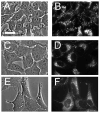Inhibition of endocytic processes by photodynamic therapy
- PMID: 22057481
- PMCID: PMC3211108
- DOI: 10.1002/lsm.21067
Inhibition of endocytic processes by photodynamic therapy
Abstract
Background and objectives: Recent studies have demonstrated an effect of photodamage on the endocytic pathway involved in recycling of membrane components. Using a series of agents with known sub-cellular targets, we explored the determinants of photodynamic inhibition of endocytic processes in three cell lines: A murine leukemia, a murine hepatoma, and a non-malignant epithelial cell line of human origin.
Study design/materials and methods: The PI-3 kinase antagonist wortmannin blocks endosomal processing pathway dependent on this enzyme, providing an indication of the "flux" of endocytosis. Microscopic observations were used to assess the effect of photodamage on this pathway. Photosensitizing agents specific for mitochondrial, endoplasmic reticulum (ER), lysosomal, and endosomal photodamage were employed.
Results: Sub-lethal photodamage directed against endosomes or lysosomes interrupted early steps in this endocytic process in the hepatoma cell line. A mechanism for these effects is proposed. Mitochondrial photodamage could interrupt endocytosis, but at levels that also induced apoptosis. ER photodamage did not affect endocytosis even at lethal levels. Somewhat similar results were obtained with other cell lines, but there were sufficient differences to indicate that the cell phenotype is, in part, a determinant of the endocytic response to PDT.
Conclusions: PDT is therefore seen to have an effect on endocytic processes. Further work will be needed to delineate the role of these endocytic effects in the array of responses to photodynamic therapy.
Copyright © 2011 Wiley-Liss, Inc.
Figures





References
-
- Scita G, Di Fiore PP. The endocytic matrix. Nature. 2010;463:464–473. - PubMed
-
- Reaves BJ, Bright NA, Mullock BM, Luzio JP. The effect of wortmannin on the localisation of lysosomal type I integral membrane glycoproteins suggests a role for phosphoinositide 3-kinase activity in regulating membrane traffic late in the endocytic pathway. J Cell Sci. 1996;109:749–762. - PubMed
Publication types
MeSH terms
Substances
Grants and funding
LinkOut - more resources
Full Text Sources
Research Materials
Miscellaneous

